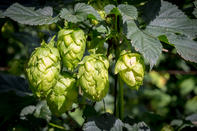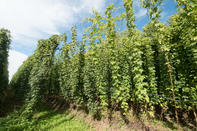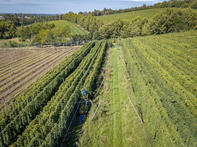Hops - A Main Ingredient in Beer
Hops are the dried female flowers of the Humulus lupulus vine, from the same plant family as Cannabis.

It is most commonly used as one of the main ingredients in beer and yields a bitter, tangy flavour while acting as a natural preservative. A hop vine is generally quite easy to grow and can reach up to 7.6 m in a season, producing up to 900 g of dried flowers.
Preparing to Plant Your Hops

The first step in growing your own hops is to decide on which hop variety to grow as there are over 80 different types to choose from.
Hop varieties are split into the three categories: bittering, aroma and dual, depending on their intended purpose. Some popular hop varieties in South Africa include the African Queen, Southern Aroma, Southern Passion and Southern Star.
Once you have choose a hop variety you will need to obtain some rhizomes. Hop rhizomes are part of the rootstock of the plant. They look like grape vines or sticks and contain the buds from which a new plant can grow.
Rhizomes should be slightly moistened, placed in a plastic bag and refrigerated to keep it cool. They can be stored in this way for several months without hassle.
Where to Grow Hops

Hops need lots of vertical space as it grows very high. They should not be grown indoors, for this reason. The ideal area will have at least three to six meters of vertical, trainable climbing space. It is best to incorporate a trellis system to support the hops as it grows - you should never let your hops grow up electrical poles. There should also be enough room on the ground for hop rhizomes to be planted a meter apart with at least 1,5 m spacing between different hop varieties.
The area you choose to plant in should also get a minimum of six to eight hours of direct sunlight every day. You should also aim to plant in a space with minimal wind and good drainage. If drainage is a problem you can build a hop hill out of a soil and gravel/sand mix to make a looser planting bed.
The Best Soil for Hops

Hops do not thrive when there is too much moisture present. Compact clay soil will lead to standing water which will rot the roots and kill your plant. The best soil for hops should be loose and porous. Make sure you remove all large clumps, stones and weeds from the soil before planting.
Loosen the soil up to 30 cm deep. You can also fertilize your soil with bone meal or blood meal. Generally speaking, soil that grows fruit and vegetables should work to grow hops.
For precision growers, ideal soil specifics are as follows:
pH of 5.5 - 8.0. General nutrient regiment where potassium (K) and phosphorus (P) are double the nitrogen content. Boron (B) as a trace mineral is also beneficial for growing hops.
The Best Time to Plant Hops

It is best time to plant hops in winter with plenty of time before you need to harvest in the summer. Planting your rhizomes too early is better than planting too late. Rhizomes can withstand temperatures as low as -6℃. Ideal planting times are from May to July.
How to Plant Hops / Rhizomes
Dig a 10 cm deep hole in the ground, roughly the length of the rhizome you want to plant. Place the rhizome horizontally in the hole.
Look closely at the rhizome and make sure that any roots present are facing groundward while any white buds are positioned skyward.
Use your hands to gently pack down the soil over the plant. You can now cover the hops with a layer of straw or mulch to prevent weed growth. Monitor the soil, keeping it moist until the plant begins to sprout through.